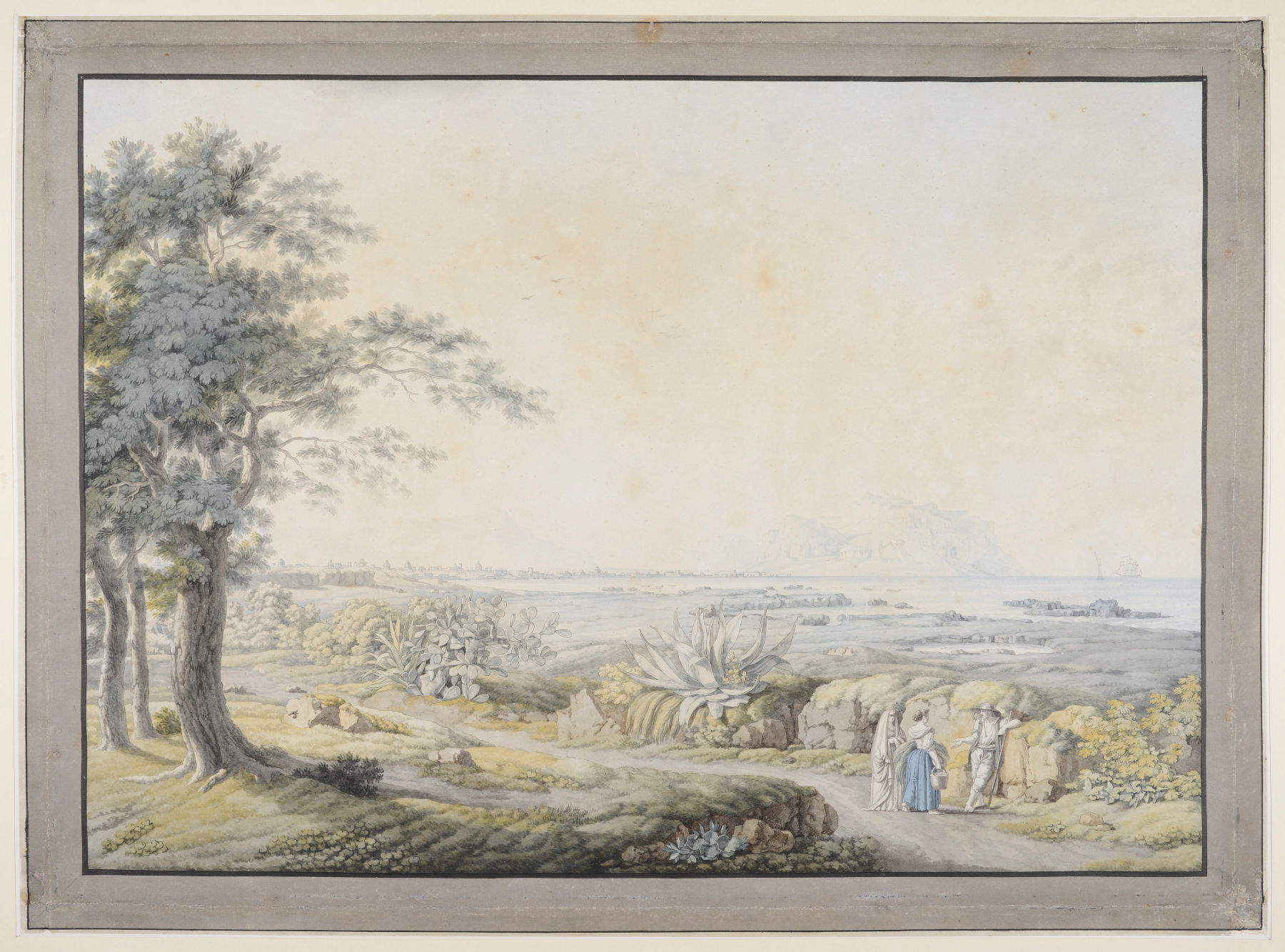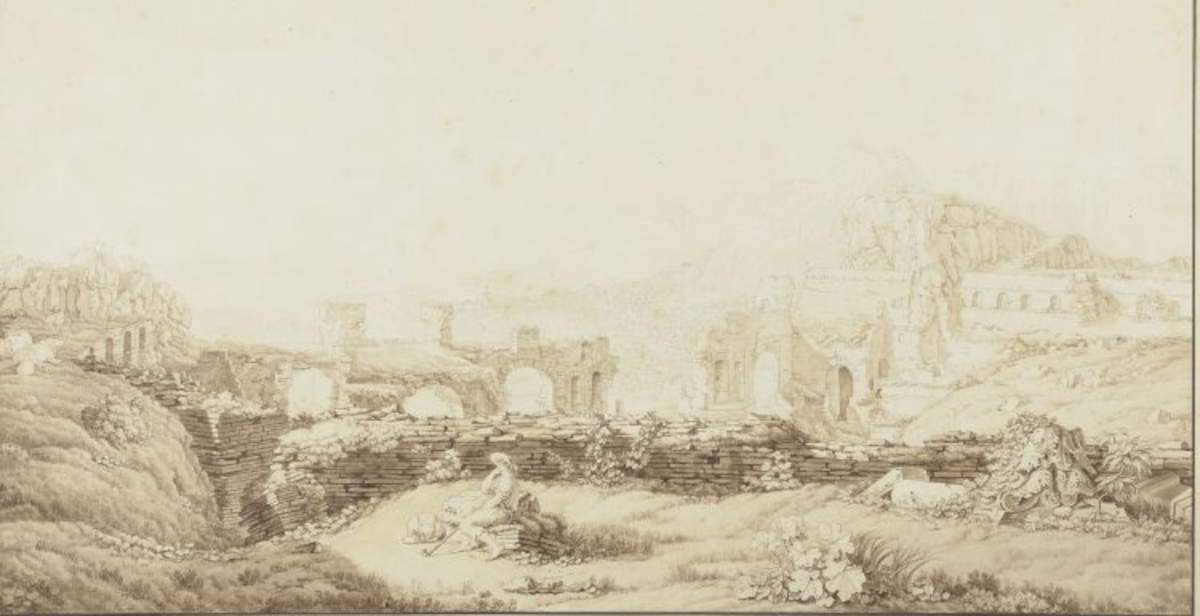On the bicentenary of the death of Christoph Heinrich Kniep (Hildesheim 1755 - Naples 1825), the Museo Casa di Goethe in Rome is dedicating its first Italian retrospective to the German draftsman. Italy in Lines - Drawings by Christoph Heinrich Kniep (1755-1825), curated by Claudia Nordhoff, will be on view from September 25, 2025 to January 11, 2026. Bringing together forty-two works from Italian and German museums, the exhibition restores the figure of an artist who often remained on the margins of art history but was capable of interpreting the light and landscapes of the peninsula with singular finesse. Kniep is best remembered for accompanying Goethe on his trip to Sicily in 1787, but his biography reveals a more nuanced story.
“Kniep’s work and biography make him a unique figure among German artists active in Italy around 1800. What distinguishes him is not only the fact that he chose to live and work permanently in our country, but also his decision to devote himself entirely to the art of drawing. His works, of extraordinary quality, have not always received the recognition they deserve. With this exhibition, the Goethe House intends to fill this gap, offering the Italian public-for the first time in such depth-a comprehensive look at his life, his production and his refined graphic artistry,” says Gregor H. Lersch, director of the Goethe House. The exhibition thus aims to fill a historiographical gap, offering the Italian public a comprehensive look at his career and technical mastery.
“Italy, and Rome in particular,” says Ernst von Siemens Kunstststiftung general secretary Martin Hoernes, “has always been a popular destination for German-speaking artists-even the painter Christoph Heinrich Kniep stayed in Rome for almost three years, forging deep artistic friendships there. The Italy in Lines exhibition, which the Goethe House Museum dedicates to him on the bicentennial of his death, is an important contribution to intercultural exchange and the rediscovery of the work of German artists. That is why we are pleased to support it in Italy and, with the Goethe House, also in a German institution abroad.”


Born into a family of butchers and brewers in Hildesheim, Kniep decided to pursue a career in art without going through an academic education. Beginning in 1778 he worked as a portrait painter in Hamburg, then in Berlin, until he settled in 1783 in Rome, the nerve center of the Grand Tour. In those years the city was attracting aristocrats and cultured travelers eager to take with them visual evidence of the Italian landscape. At 18 Via del Corso, the same location that now houses the museum, Kniep shared rooms with other German artists, including Johann Heinrich Wilhelm Tischbein, Friedrich Bury, and Johann Georg Schütz. His friendship with the landscape painter Jakob Philipp Hackert oriented him toward landscape drawing, a genre that became his main field of research.
In 1785 he moved to Naples, where two years later he met Goethe. The poet, during his trip to Sicily, found in his sketches an irreplaceable visual support: views of temples, ruins and Mediterranean coasts executed with precision and luministic sensitivity. Some of those drawings, enriched with sepia ink or watercolor touches, were kept by Goethe himself in the attic of his Weimar home, where he reserved Kniep a place of honor alongside the most esteemed artists. The draughtsman, for his part, recognized the meeting with Goethe as a turning point, writing to the poet that it was he who had “set the point from which the circle of my happiness began.”
After the trip, Kniep consolidated his career between Naples and Germany, receiving commissions from the Weimar court and foreign travelers. He remained in Naples even during the political turmoil of the turn of the century: he saw the French occupation of 1799, the Bourbon return in 1816 and continued to work for French patrons, local aristocrats and international collectors. His discreet life and the secluded nature of his art made him a little-known figure, but deeply esteemed by his contemporaries. Danish writer Friederike Brun wrote of him in 1796, “I have never seen sketches like his. Each one is an academic masterpiece. Everything is perfect, everything executed with the most elegant refinement. He is a confidant of nature.” Kniep died in Naples on July 11, 1825, and was buried in the city’s Protestant cemetery.


The exhibition at the Goethe House traces all stages of his activity. It opens with early Hamburg portraits and Roman sheets, including a view of the Colosseum and a rare depiction of the Temple of the Sibyl in Tivoli. This is followed by drawings and watercolors devoted to Naples and its environs, such as Looking at the Temples of Paestum and View of Cava de’ Tirreni. Two works by Hackert and Tischbein, artists linked to him by deep friendship, introduce the context in which Kniep matured his graphic language. Also in the exhibition is Tischbein’s Electra, Orestes and Pilades, created during their cohabitation on Via del Corso.
Ample space is reserved for his trip to Sicily, documented by a series of drawings and watercolors, including the View of the Theater of Taormina. One of the highlights of the exhibition is the juxtaposition of two sheets from the Klassik Stiftung Weimar: a depiction of the Tomb of Theron in Agrigento drawn by Goethe and Kniep’s version, displayed side by side to testify to the visual dialogue between the two travelers. Subsequent sections illustrate the evolution of his style toward more complex compositions, such as ideal views inspired by the Odyssey, alongside highly precise botanical studies that reveal an intense scientific interest in Mediterranean flora. The exhibition closes with a pair of drawings dated 1825, the last ones executed before his death.
In addition to the collection of the Goethe House, the works come from the Klassik Stiftung Weimar, the Goethe-Museum Anton-und-Katharina-Kippenberg-Stiftung in Düsseldorf, the Hamburger Kunsthalle and the Istituto Centrale per la Grafica in Rome. The exhibition is accompanied by a bilingual catalog, supported by the Ernst von Siemens Kunstststiftung and published by Edition Fichter, with essays by Claudia Nordhoff, Christoph Orth, Jutta Eckle and Andreas Stolzenburg. The volume, edited by Gregor H. Lersch and Claudia Nordhoff, is the first comprehensive study of the artist also available in Italian.
 |
| Italy on the lines: the first Italian retrospective devoted to Christoph Heinrich Kniep |
Warning: the translation into English of the original Italian article was created using automatic tools. We undertake to review all articles, but we do not guarantee the total absence of inaccuracies in the translation due to the program. You can find the original by clicking on the ITA button. If you find any mistake,please contact us.